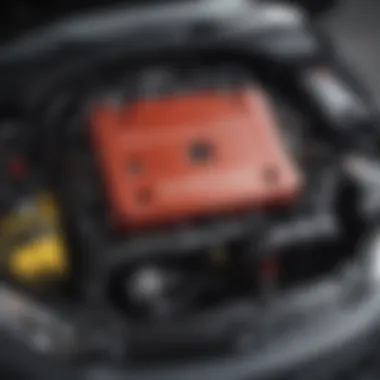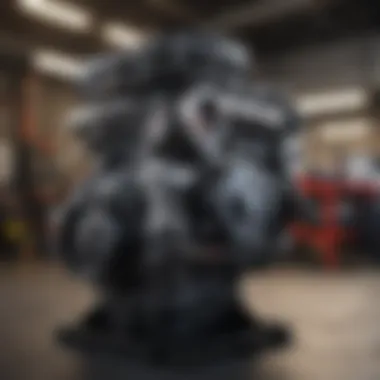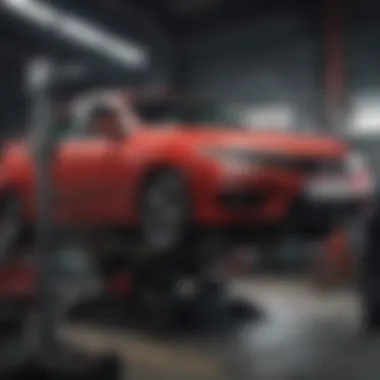Honda Civic Motor Swap: Expert Insights and Guidance


Intro
Performing a motor swap, especially in a widely recognized vehicle like the Honda Civic, is a pursuit that excites many automotive enthusiasts. Given the Civic’s long-standing reputation for reliability and performance, upgrading its engine can substantially reshape the driving experience. Motor swaps provide an opportunity to personalize your vehicle to fit your needs, whether that's improved acceleration, enhanced handling, or simply greater power.
However, swapping motors is not merely about power. It brings with it a variety of considerations. Owners must evaluate compatibility, potential costs, legal implications, and performance expectations. Knowledge of various engine options and the skill level required for the swap are also essential aspects of the journey. Through this guide, we outline the various citizens searching for precise and actionable insights into what it means to undertake a Honda Civic motor swap.
Overview of the Vehicle
A Honda Civic represents more than just a model of automobile; it embodies a segment of automotive relaxation and tuning. While models vary over time, each generation of Civic has maintained a close connection with its drivers. Whether it's the zippy engine dynamics or the comfortable cabin, Civic cars attract diverse audiences globally.
The chassis offers good interior space for passengers, making it practical for daily use with sporty aesthetics that make it appealing to younger drivers. Each version has its unique quirks and potentials—a testament to Honda's commitment to evolution without forgetting tradition.
Performance Analysis
Delving into performance, the Honda Civic is often seen as tunable, inviting users to explore its limits. For some, performance is defined simply in terms of acceleration and top speed. Thanks to a lightweight design and efficient engineering, the Civic boasts responsive handling vital for spirited driving.
Upgrading to a new engine during a swap can significantly improve performance metrics. Significant enhancements, for example, might come when integrating more robust Honda K-series engines, known for their balance of power and efficiency. Just remember, the right choices can lead to performance outputs that surpass stock specifications.
Design and Interior Features
The design of the Honda Civic blends aggressiveness and elegance. Outward appearances appeal to various tastes derived from its different generations. Interior design favors practicality, with user-friendly controls and well-placed storage areas. An intuitive dashboard supports tech integrations from the latest infotainment systems. Sufficient space in both front and rear seats ensures comfort alongside sportiness during longer journeys.
New engines often come with compatibility layers, necessitating custom mounting and possibly bolder rise in aesthetic appeal. Be prepared to address those expectations as part of the engine swap.
Safety Ratings and Specifications
Safety is a notable trait that Honda emphasizes across its fleet. While swapping might seem straightforward, safety standards remain paramount with an upgraded engine. Ensure ergonomics and form factor of upgrades are compliant with regulations championed by the vehicle’s history in the market. Review safety ratings to assess overall stability and crash characteristics post-swap to ensure risk remains minimized.
Value for Money
Value relating to any modification must address not only initial investment but also long-term return on investment. Owners must consider different factors such as potential repair costs, upgrades in overall driving experience, and how well the vehicle holds its value post-motor swap. Gathering data and drawing comparisons with originally fitted motors can aid in discerning financial feasibility swiftly.
Prelims to Honda Civic Motor Swaps
Motor swaps have become an increasingly popular topic among automotive enthusiasts. Understanding them is critical. This article addresses not just the mechanics, but also the implications of this engaging task. Honda Civics stand out for their versatility, affordability, and performance upgrades.
Understanding Motor Swaps
A motor swap involves replacing the engine of a vehicle. It promises a variety of benefits, including increased power and improved performance. However, undertaking a motor swap is not merely a mechanical task; it requires careful planning and consideration. Skills and knowledge in automotive mechanics are needed as well as a clear vision of the end goal.
When considering a swap, knowing your current setup is essential. Each engine has its specific compatibility and requirements. Thus, instructions for the swap process should be heeded closely for success. By grasping the fundamentals of motor swaps, one becomes better prepared when exploring this journey.
Why the Honda Civic?
The Honda Civic is revered in the automotive community. Its lightweight design and responsive handling make it an excellent candidate for motor swaps. Due to its compact dimensions, many engine models fit seamlessly, optimizing the vehicle's performance. Additionally, Civics enjoy immense aftermarket support—a strong community that offers parts and advice to those venturing into swaps.
Another key aspect is the Civic's strong reliability. Engine options, like the B-Series, K-Series, or J-Series, improve power without sacrificing dependability. These swaps have been highly documented with community-driven resources, helping newcomers navigate challenges when venturing into this transformative experience.
Choosing a Honda Civic for a motor swap is practical due to the availability of components as well as forums like Reddit to share insights and strategies. So, whether you're enhancing performance or contributing to a car project, studying Honda Civic motor swaps proves rewarding.
Initial Considerations
When tackling a Honda Civic motor swap, there are fundamental factors that could shape the success of your project. Initial considerations set the stage for everything that follows. Understanding what you want to achieve, knowing your budget, and assessing the legal landscape are vital aspects of this endeavor. These will help you make informed choices and mitigate potential risks.


Assessing Your Goals
Before proceeding with a motor swap, clarity on your objectives is crucial. This phase involves understanding your driving needs and performance aspirations. For instance, do you seek a more powerful engine for exciting speed, or are you prioritizing fuel efficiency? By assessing your goals, you can determine specific engine choices that align with your needs. Consider factors such as:
- Type of driving: Track, daily commute, or a mix?
- Desired power: How much horsepower or torque do you want?
- Overall performance: Do you need better handling, acceleration, or braking?
Understanding these goals will act as a foundation for every decision you make, influencing everything from engine selection to component upgrades.
Budgeting for the Swap
Any motor swap comes with financial implications. Budgeting is not just about purchasing the new engine; it's also about understanding the associated costs of installation and potential modifications. Typically, costs involved can include:
- Engine cost: The price of the new engine can vary significantly based on the make and model.
- Labor costs: If you employ a professional mechanic, labor charges can add up.
- Supporting parts: You might need additional parts like mounts, wiring harnesses, and exhaust manifold adaptations.
- Unexpected repairs: Always keep a reserve for any unforeseen issues during the process.
By mapping out these expenses ahead of time, you can prevent financial strain and align your project with realistic expectations.
Legal Considerations and Regulations
Motor swaps often bring about questions regarding legality, which is essential for optimum safety and compliance. It's vital to understand local and state laws, as regulations can differ significantly. Key points to consider include:
- Title reassignment: In some regions, you may need to update your vehicle's title upon installing a different engine.
- Emissions standards: Ensure that the new engine meets environmental regulations, as failure can result in fines or halted registrations.
- Insurance impacts: Modifying the engine could affect your existing insurance policy. Be prepared to speak with your insurance provider to cover your new setup appropriately.
By being proactive about these legal matters, you can smooth the path nearer to a successful and compliant motor swap.
Remember, staying informed is your best defense against potential legal pitfalls.
Choosing the Right Engine
Choosing the correct engine for a Honda Civic motor swap is critical. The engine choice highly impacts your car’s performance, handling, and long-term compatibility. This decision greatly influences how the vehicle feels on the road, affects everyday drivability, and how enthusiasts will perceive your build. Thus, understanding various engine types and their characteristics is paramount to achieving a successful swap.
Popular Engine Options for Honda Civic Swaps
When considering an engine swap, it's vital to identify engines popular among Honda Civic enthusiasts. Some favored options include these:
- K-Series Engines: Notably the K20 and K24 engines. They deliver both efficiency and a power boost, making them a favorite.
- B-Series Engines: Engines like the B16 and B18 are iconic in the aftermarket community. They offer a great balance between tuning potential and reliability.
- H-Series Engines: Engines such as the 2 have noticeable horsepower, though compatibility requires special consideration.
- General Motors LS Series: Swapping a small block LS is becoming popular among extremists. While they ensure high power, they may present challenges in terms of fitting and electronics.
Each option provides distinct advantages and challenges, so researching and aligning with your project goals is essential.
Performance vs.
Reliability
In the world of motor swaps, a dilemma often arises between pursuing performance or ensuring reliability. Fast engines can undoubtedly increase speed but often make daily driving complicated. High-output motors may demand more maintenance and vigilance regarding cooling and lubrication.
Consider the following aspects:
- Performance Aspects: High-performance engines enhance speed. Monitor tuning requirements after swapping, to prevent stress on components.
- Reliability Factors: Some engines, while less powerful, provide proven reliability and lower wear. Reliability often matters when the vehicle must serve daily tasks.
- Balance Approach: Aim for an engine combination supoprting performance needs while ensuring an acceptable level of reliability to meet day-to-day requirements.
Compatibility Issues to Consider
Compatibility poses challenges when upgrading or swapping engine types in the Honda Civic. This affects functionality in ways crucial for your build.
Several factors must be evaluated:


- Physical Fitment: Ensure the chosen engine fits within the engine bay dimensions without extensive modifications.
- Mounting Kits: Depending on the engine, you may need specialized mounting kits, which affect the swap complexity.
- Transmission Compatibility: Matching the existing transmission with the new engine is consequential. Research transmission options, or possible modifications needed.
- Electronics and Wiring: Swapping engines that come from diffrenet model years or platforms might require extra electronic adaptations, which complicate installation.
Considering these compatibility issues beforehand can save headaches further down the line, allowing for a smoother swap experience.
Ultimately, the right engine not only detemines performance but also affects the ease of implementation. Take time to reseach the available options.
The Motor Swap Process
The process of swapping an engine into a Honda Civic is central to maximizing the vehicle’s performance and exploring new opportunities for customization. An engine replacement can lead to a notable enhancement in acceleration, power delivery, and overall driving experience. Understanding the motor swap process is crucial for automotive enthusiasts who aim to both improve their vehicles and tap into the wider car modification community. This section breaks down the essential tools, preparations, and the methodologies involved in successfully executing a motor swap.
Tools and Equipment Needed
Before starting the swap, it is crucial to gather necessary tools and equipment. Having the right tools on hand will not only make the job easier but can also ensure safety and precision during the process. Below are common items needed:
- An engine hoist or crane
- Jack stands and a hydraulic jack
- Wrenches and sockets in various sizes
- Screwdrivers (flat and Philips)
- Pliers and snips
- A comprehensive repair manual specific to the Honda Civic model
- Torque wrenches
- Wire connectors and electrical tape
- Safety gear (gloves, goggles, etc.)
It might be worth investing in a few spare parts too, like gaskets and fluids, as these may be required during the swap.
Preparation Steps Before the Swap
Preparation for an engine swap should not be overlooked. Before diving into the swap, certain steps will streamline the process. Start with the following:
- Know Your Model: Determine the specific Honda Civic model you own, as various models have unique specifications that will influence your engine choice.
- Gather Documentation: Obtain the service manual for instructions on disassembling your vehicle and wiring guidelines for the new engine.
- Rally the Right People: A support team can be invaluable. Consider recruiting hand friends or a mechanic experienced in motor swapping.
- Establish a Workspace: Prepare a clean area with enough room to maneuver the Civic and accommodate the machinery. Proper ventilation is also essential.
- Disconnect the Battery: Always disconnect the battery before starting to prevent any electrical mishaps.
By thoroughly preparing in advance, one can save time, reduce headaches, and enhance the likelihood of a successful swap.
Step-by-Step Motor Removal and Installation
Executing a motor swap involves a structured series of actions, particularly removal and installation of the engine. Below is a simplified overview of the motor removal and installation process:
Removal Procedure:
- Drain all fluids like oil and radiator coolant to prevent spills.
- Remove the engine cover, intake and exhaust components, and any connected wiring harnesses.
- Disconnect the fuel lines and exhaust system.
- Undock the transmission from the engine if attached, and support it with a trans jack if necessary.
- Use the engine hoist to carefully remove the old engine from the bay.
Installation Procedure:
- Prepare the new engine by ensuring all necessary fittings, gaskets, and sensors are installed beforehand.
- Place the new engine carefully into the engine bay using the hoist, aligning it with the mounts.
- Reconnect all hoses, wires, and components that were removed earlier.
- Ensure everything mechanically is fastened properly before proceeding to reattach the transmission.
- Fill fluids like oil and coolant before attempting the initial start.
Engaging in a motor swap without proper research and preparation can lead to complications. Take time to consider every step and decision involved.
This structured outline hopefully provides necessary clarity, helping maintain confidence during each stage of the motor swap process.
Post-Swap Adjustments
Post-swap adjustments are crucial for optimizing the performance of your Honda Civic after replacing the motor. Even done right, the benefits of your new engine may not be fully realized unless the setup is fine-tuned post-installation. Whether for a simple upgrade or a high-performance swap, the adjustments will affect driveability, responsiveness, and overall enjoyment of the vehicle.
Tuning the Engine for Optimal Performance
Upon completing the motor swap, tuning the new engine is one of the most beneficial subsequent steps. Tuning refers to modifying the engine's management system to achieve peak efficiency and maximize power output.
Key Aspects of Engine Tuning
- ECU Reprogramming: Often, you will need to update the Engine Control Unit’s parameters to align with the characteristics of the new engine. This step can be performed using chip tuning or flash tuning methods.
- Fuel Mapping: Adjust fuel delivery to ensure the right air-fuel mixture is used. An improper mix can cause reduced performance or even damage the engine.
- Ignition Timing: Fine-tuning spark timing is crucial for optimizing throttle response and power performance. Depending on the engine’s design, this will be key as higher performance may require different ignition strategies.
- Dynamometer Testing: Using a dynamometer can help you to accurately measure the outcome of your adjustments, allowing for a clear understanding of how performance is improved.


For many enthusiasts, a dynamometer test provides invaluable insight into the swap's success, illustrating gains in horsepower and torque. However, it is vital to understand your engine's characteristics to make an effective adjustment.
Implications of a Motor Swap
The implications of performing a motor swap in a Honda Civic reach beyond the immediate mechanical changes. Upgrading the engine can offer significant benefits but it’s crucial to understand the associated factors that may come into play. This section delves into the effects on vehicle value, maintenance obligations, and the resources that are available in the modification community. Consider these aspects seriously as they can enhance or alter the appeal of your newly swapped engine.
Impact on Vehicle Value and Insurance
One of the first thing you should acknowledge after a motor swap is its effect on your car's value. An engine swap can substantially increase the vehicle's worth, especially if it is a popular or high-performance engine. Fans tend to appreciate a well-done swap, particularly if you document it properly. However, potential buyers may hesitate due to concerns about reliability or legality.
Insurance can be affected too.
Upgrading to a different engine might require you to adjust your coverage plan. Car insurance companies regard major modifications as increased risk. This means that your premiums may rise. You might need to find an insurance provider that understands and accommodates modified vehicles.
Carefully manage these possibilities:
- Document every aspect of the installation for potential buyers.
- Notify your insurance underwriter about the engine swap.
The worth of a vehicle is often more subjective once deep modifications happen. Understand your audience if you plan to resell.
Long-term Maintenance Considerations
Another significant implication involves long-term maintenance. The engine swap can require unique considerations regarding routine upkeep that differ from stock engine maintenance schedules. Performance engines might demand more frequent oil changes, specialized fluids, and specific parts that may not be readily available.
Factors to consider include:
- Performance Resonance: An aftermarket engine installed generally comes with a higher demand for maintenance. Adhering strictly to the manufacturer's guidelines for the new engine is advisable.
- Customized Components: Upgraded components like intercoolers, turbo systems, or exhausts may need specialized care and replacements.
- Compatibility Checks: Regular inspections must consider the compatibility with existing components, particularly with the vehicle's braking and suspension systems.
Community and Resources for Support
This aspect is possibly the most enriching following a motor swap. Many forums, social media groups, and local clubs exist for automotive enthusiasts, offering both support and advice. Engaging with these communities can provide immeasurable advantages, ranging from troubleshooting issues to discovering performance tips.
Key resources include:
- Forums: Websites like Reddit have dedicated threads for Honda Civic swaps.
- Social Media Groups: Facebook groups focused on Honda Civic upgrades often share insights and information from mechanics.
- Local Car Clubs: Networking allows you to meet with experienced members who can guide you through the complexities of maintenance.
By leveraging these contacts, you can accelerate your learning curve and avoid common pitfalls that new enthusiasts face. Involving yourself in these communities fosters a supportive environment that can greatly enhance your ownership experience.
Overall, understanding the implications of a motor swap provides a complete picture of what can be gained and lost with your Civic modifications. Always proceed with a blend of enthusiasm and caution, thoroughly preparing yourself for the myriad of challenges and opportunities a motor swap entails.
Epilogue
Motor swapping a Honda Civic is a significant undertaking that requires serious consideration. This article outlines various aspects of engine replacement, offering insights into the various benefits and implications associated with such a procedure. Understanding the entire topic ensures that enthusiasts and prospective buyers can approach this project with confidence. The swap may enhance the vehicle's performance. This can lead to a more engaged driving experience. Additionally, being familiar with the mechanics behind an engine swap allows one to make informed choices, prioritizing reliability and longevity.
Reflecting on the Swap Experience
After completing a motor swap, it is essential to reflect on the overall experience. Evaluating how well the engine performed versus expectations provides vital insights. Some enthusiasts find this upggrade leads to a more satisfying driving experience. Important points to consider include:
- Performance Improvement: Was the vehicle's acceleration, handling, and overall performance noticeably enhanced?
- Challenges Faced: Did unexpected hurdles occur during the installation? Understanding these issues can help others avoid similar pitfalls.
- Satisfaction with the Result: Are you pleased with the decision to swap the engine? Assessing personal fulfillment plays a key role in judging the swap experience.
Experiencing the swap is a rich learning opportunity. Sharing knowledge in community forums or with fellow enthusiasts further amplifies the value of the endeavor, leading others to potentially benefit from your experience.
Future Trends in Engine Swapping
The landscape of engine swapping is evolving. Technological advancements continue to influence this field. Recognizing these future trends can offer better opportunities for Honda Civic fans. The following elements likely shape the future of motor swapping:
- Electrification: With the rise in electric vehicle technology, enthusiasts may explore the feasibility of swapping traditional engines for electric motors in dashboard applications.
- Increased Accessibility of Information: As more resources become available, DIY enthusiasts will gain easier access to workshops, guided content, and community feedback on engine swaps. Websites like Wikipedia or forums on Reddit can be beneficial.
- Performance-oriented Parts Accessibility: The aftermarket industry continues to boom, ensuring that parts are easy to source, further enhancing the vehicle's efficiency and capability holes.
Understanding these trends prepares future modifiers to further optimize their vehicles, ensuring a competitive edge in custom car circles.
In looking to the future, the trends seen in the auto industry will greatly affect motor swaps. Keeping an eye on evolutions in performance parts and tech ensures success in future endeavors.







